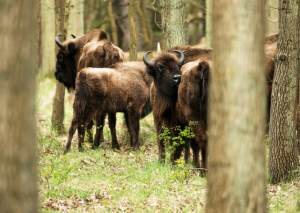
Rewetting our uplands; is it always a good idea?
In modern conservation and catchment management there has been a great deal of emphasis on rewetting landscapes in order to restore the impressive ecosystem services the mires, bogs and fens would have provided prior to their drainage for agricultural purposes.
There is no question that these habitats are worthy of protection and are important for carbon sequestration, landscape level drought and flood protection and habitat for important species.
In some circumstances, however, other forms of ecological restoration should be considered. A regenerative land management approach focuses on improving the four ecosystem processes of the water cycle, mineral cycle, energy flow and community dynamics to help achieve high successional state.
Regenerative agriculture is a form of farming that seeks to mimic natural processes to build soil and better manage land and livestock health.
Holistic Management is a framework developed by Biologist Allan Savory to help manage complexity and make good informed decisions. It is especially useful for land managers trying to balance the ‘triple bottom line’ whilst increasing the function of the ecosystem processes.
As a holistic land manager and consultant in regenerative agriculture I am consciously a ‘generalist’ not a ‘specialist.’ We have many highly skilled specialists in the field of conservation, they each bring an important perspective and deep understanding of a focused subject matter. If anything, my ‘specialism’ is to be able to keep a broad perspective of the management project, this enables me to see ‘the bigger picture’ and its full context.
In order to make good decisions, we must have a clear context that is agreed upon by all stakeholders, so we know what we hope to achieve.
As Allan Savory say’s, we can’t decide if it’s a good idea to light a fire until we know what we are trying to make happen with the use of fire. Do you want to burn down a house or to warm the hearth? Many of our land management decisions are made to get away from a problem instead of considering what we want to move towards and why.
Once we have clarity over what we want to achieve from the use of a tool then it’s easier to make an informed decision about its use. We must consider the economic, ecological and social impact of the decision over long and short terms. Then we can be sure we are making a ‘holistic’ decision.
Holistic management helps us understand how to work with the self-organising nature of living systems. One of the keystone principles of holistic management is that we cannot apply logical reductionist thinking to a complex, self-organising, living system. Evidence suggests some of our biggest environmental errors have arisen when we have assumed nature will give us predictable outcomes from previously tried management prescriptions.
We could conclude that if we recreate the abiotic conditions of area of land then the biotic components of the community will once again be restored, and the function of that landscape will match that of the time prior to modification. In holistic management we assume it will be more complex than this and our framework helps us to navigate the change.
To measure the effectiveness of our holistic management we can use the Savory Institute developed Ecological Outcome Verification (EOV), this is a scientifically robust technique that focuses on monitoring the effectiveness as the ecological processes instead of reducing the focus to single metrics such as species or hydrological outcomes.
The complex and self-balancing ability of a pristine landscape cannot be overstated. Here are just a few ways a truly natural system regulates itself.
- Predators regulate herbivore grazing to minimise overgrazing and browsing, this ensures a wide range of habitats are represented and increases the overall complexity and resilience of the landscape.
- Herbivores under predation bunch and move in groups optimising the animal impact and therefore the mineral cycling of the sward. They create valuable deadwood in woodlands by crashing through dense areas of trees and opening areas of canopy to facilitate the opportunity for new seedlings to establish.
- Abundant and diverse bird life, along with herbivores, transport minerals back to higher and more depleted land along with the seed they carry to maintain diversity in the field and tree layers.
- Selection pressure on all species ensures only the members of a population best adapted to thriving in that environment will succeed. Unsuccessful casualties provide valuable nutrients back into the food web.
- A diverse range of plants can grow tall and deep which increases the diversity and functionality of the soil microbiome and the energy flow (food for all species being passed through the food web) extending the growing season – providing more food to more species for more months of the year.
- A diverse soil microbiome has a fully functional ‘microbial bridge’ which allows plants to take up all 42 (or more) nutrients indirectly from the crystalline structures in the rock rather than rely on diffusion from the soluble pool. These fully nourished plants then pass these nutrients through the food web allowing all species to thrive and successfully resist disease or better resist pest attack.
- A diverse microbiome that includes mycorrhizal fungi and includes the microscopic predators of fungi and bacteria helps control and reduce the volume of inorganic nutrients in the soluble pool. These soluble nutrients are scarce in pristine environments and could potentially wash out of the system. Microbes take up these nutrients and hold them in their living biomass, this improves soil structure so soluble nutrients – released from micro-organism excretions – are held tightly within this aggregated soil. This system provides a more stable source of the full range of minerals on demand as a plant photosynthesises and exchanges exudates with the microbiome.
- A diverse microbiome creates macro aggregates in which soil PH is controlled and able to adjust to accommodate an astonishing array of plant species that would not be found in a simplified soil structure on the same underlying geology.

Most of the land in the UK has been modified for agricultural production, through a combination of drainage, set stock grazing, tillage, introduced chemicals, nutrients or productive plant species and the widespread removal of predators or competitors who are deemed to be a threat to livestock.
The shift from this self-sustaining ecosystem to an agricultural landscape has been a slow one. As is the case with all slow changes, the phenomenon of ‘shifting baseline syndrome’ can occur.
At each stage of the shift some of the functionality is lost and the effectiveness of its ability to self-sustain and regenerate is reduced. Each generation that witnesses this stage assumes that the state of the environment within living history is the best it can be.
We no longer have living memory, or even many stories, to remind us of the truly enormous potential biomass production and ecosystem services of these pristine environments.

We now face a severely degraded landscapes and are benchmarking potential areas for ecosystem restoration on the wetter more functional and biodiverse uplands. The intention is to study this ecosystem and use modern science to focus on certain functions to justify the restoration to a wealthier state.
Here are some examples of the assumptions we are making about re-wetting landscapes:
- Wetter landscapes sequester carbon and therefore are the best choice for reducing the GHG burden on a warming climate.
- Wetter landscapes offer the best flood mitigation potential.
- Wetter landscapes reduce the nutrient enrichment of water courses.


No Comments